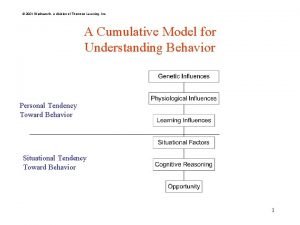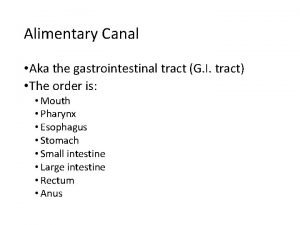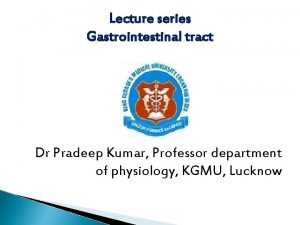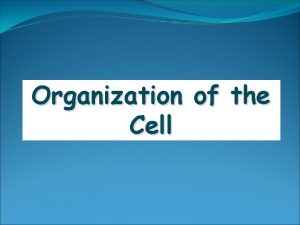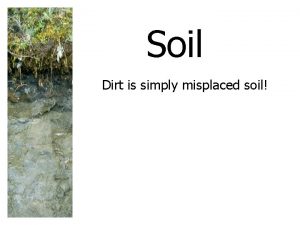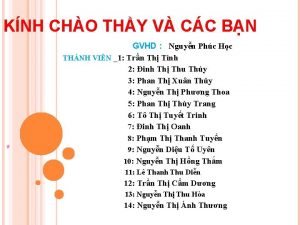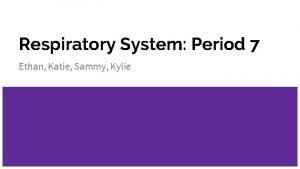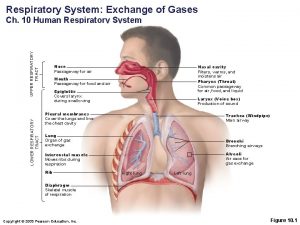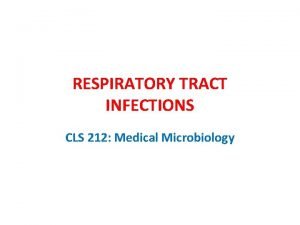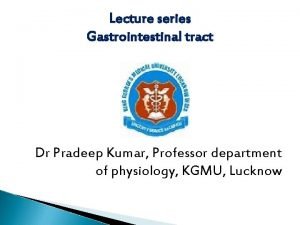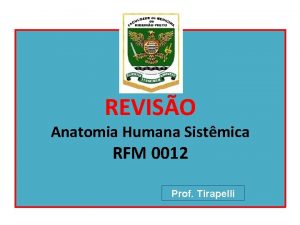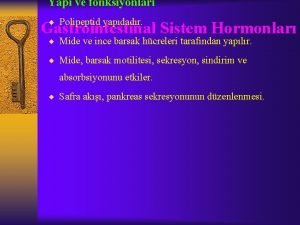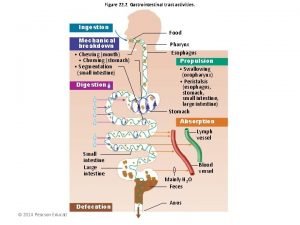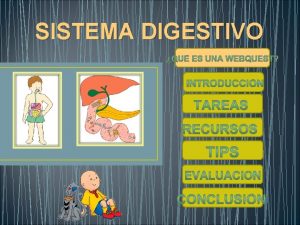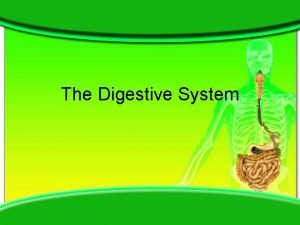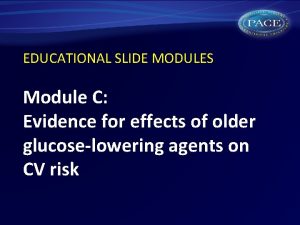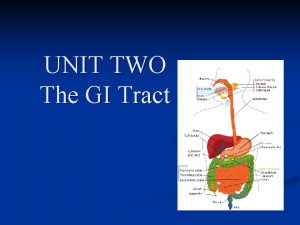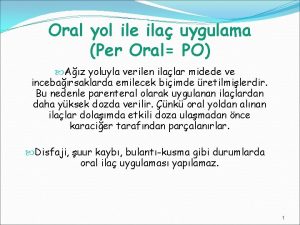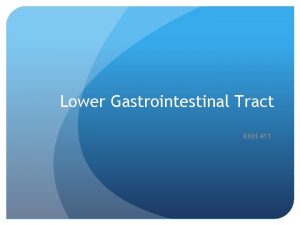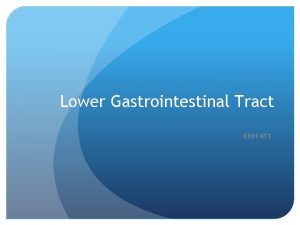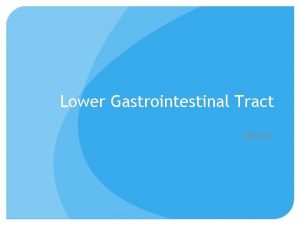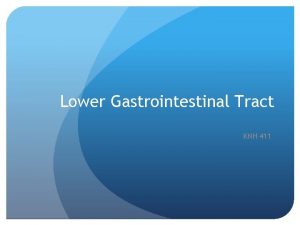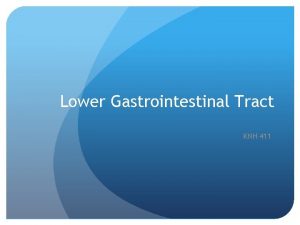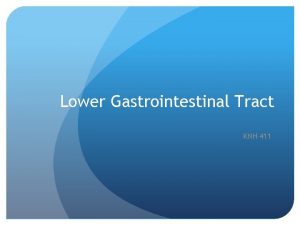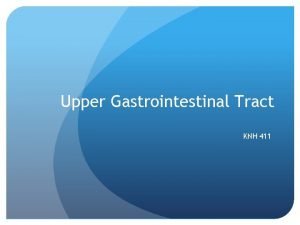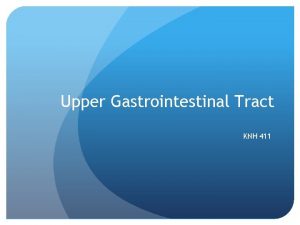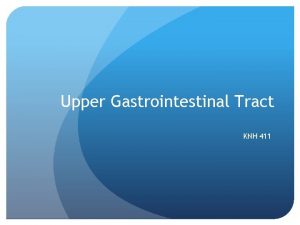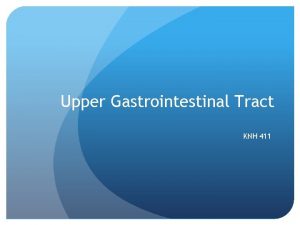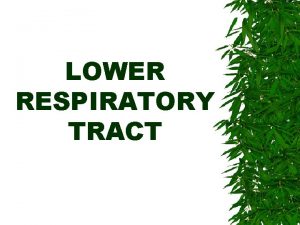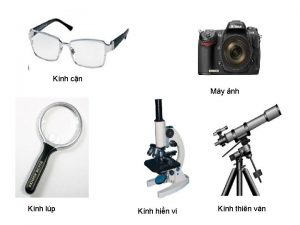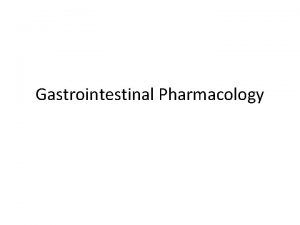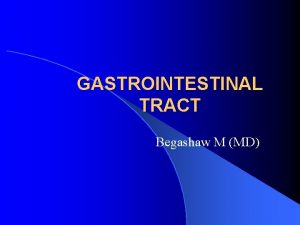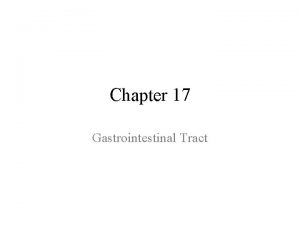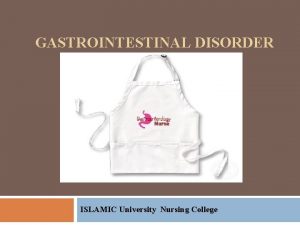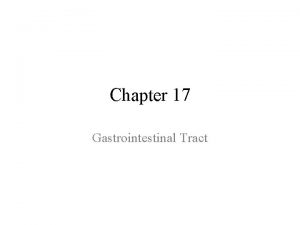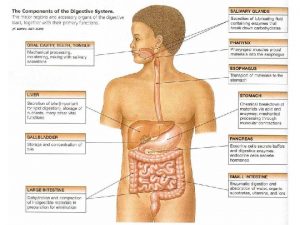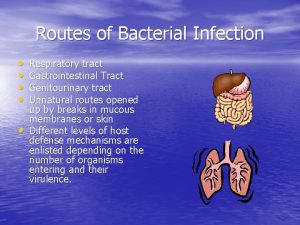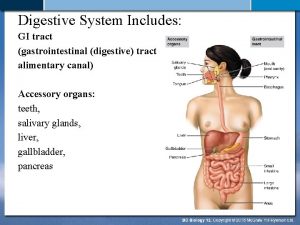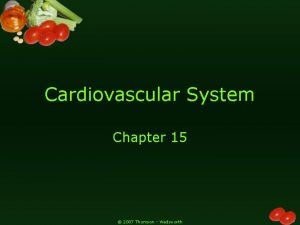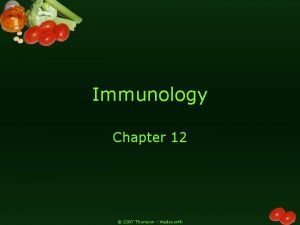Lower Gastrointestinal Tract KNH 411 2007 Thomson Wadsworth







































- Slides: 39

Lower Gastrointestinal Tract KNH 411


© 2007 Thomson - Wadsworth



Pathophysiology: Lower GI Tract Malabsorption - maldigestion of fat, CHO, Protein Decreased villious height, enzyme production Decreased transit time resecting of that area; surgery

Pathophysiology: Lower GI Tract Malabsorption - fat Steatorrhea Fat-soluble vitamins malabsorbed Potential for excess oxalate Abdominal pain, cramping, diarrhea Dg; fecal fat test or D-xylose absorption test, or small bowel x-ray

Pathophysiology: Lower GI Tract Malabsorption - Fat – Nutrition Restrict fat 25 -50 g/day Use of MCT supplements Pancreatic enzymes individuals who have chronnes will be taking pancreatic enzymes before their meals

Pathophysiology: Lower GI Tract Malabsorption - CHO Lactose malabsorption Increased gas, abdominal cramping, diarrhea Restrict milk and dairy products Products such as Lactaid can be rec.

Pathophysiology: Lower GI Tract Malabsorption - protein Protein-losing enteropathy Reduced serum protein lab value you would be looking at Peripheral edema system or cells can not hold in the water

Pathophysiology: Lower GI Tract Malabsorption - Nutrition Therapy Results in weight loss Treat underlying disease/ nutrient being malabsorbed

Pathophysiology: Lower GI Tract Celiac disease Genetic and autoimmune Occurs when alpha-gliadin from wheat, rye, malt, barley are eaten Infiltration of WBC, production of Ig. A antibodies

Pathophysiology: Lower GI Tract Celiac disease - pathophysiology Damage to villi Decreased enzyme function Maldigestion and malabsorption Occurs with other autoimmune disorders


Pathophysiology: Lower GI Tract Celiac disease - clinical manifestations Diarrhea, abdominal pain, cramping, bloating, gas Muscle cramping, fatigue Skin rash Higher risk for lymphoma and osteoporosis

Pathophysiology: Lower GI Tract Celiac Disease - Diagnosis/Treatment/Prognosis Biopsy of small intestinal mucosa Reversal of symptoms following gluten-free diet Refractory CD; d/t coexisting disease

Pathophysiology: Lower GI Tract Celiac Disease - Nutrition Intervention Low-residue, low-fat, lactose-free, gluten-free diet Identify hidden sources of gluten Specialty products


Pathophysiology: Lower GI Tract Irritable Bowel Syndrome (IBS) Pain relieved with defecation Onset associated with change in frequency of stool Onset associated with change in form of stool Eliminate “red flag” symptoms

Pathophysiology: Lower GI Tract IBS Most common GI complaint Etiology unknown Increased serotonin, inflammatory response, abnormal motility, pain they do not know why this is

Pathophysiology: Lower GI Tract IBS - clinical manifestations Abdominal pain, alterations in bowel habits, gas, flatulence Increased sensitivity to certain foods lactose, wheat and other diet foods Concurrent dg

Pathophysiology: Lower GI Tract IBS - Treatment Guided by symptoms Antidiarrheal agents Tricyclic antidepressants, SSRIs Bulking agents, laxatives Behavioral therapies

Pathophysiology: Lower GI Tract IBS - Nutrition Therapy Can lead to nutrient deficiency, underweight Decrease anxiety, normalize dietary patterns

Pathophysiology: Lower GI Tract IBS - Nutrition Therapy Assess diet hx what is triggering the IBS concerns Assess nutritional adequacy 24 hours recall Focus on increasing fiber intake 25 grams per day Adequate fluid help with GI motility Pre- and probiotics Avoid foods that produce gas and swallowed air, for example the use of straws



© 2007 Thomson - Wadsworth


© 2007 Thomson - Wadsworth


Pathophysiology: Lower GI Tract IBD - Nutrition Therapy Malnutrition May need to increase kcal, protein, micronutrients

Pathophysiology: Lower GI Tract IBD - Nutrition Interventions During exacerbation Supplement Assess energy needs + stress factor increase any 200 -500 calories per day May need to increase protein 1. 5 -1. 7 g per kilo Low-residue, lactose-free diet Small, frequent meals

Pathophysiology: Lower GI Tract IBD - Nutrition Interventions May use MCT oil Restrict gas-producing foods Increase fiber and lactose as tolerated if not in crisis Advancement of oral diet individual basis Multivitamin want them to have one. B 12 iron zinc calcium magnesium and copper are all the ones that are included in your vitamin

Pathophysiology: Lower GI Tract IBD - Nutrition Interventions During remission/rehabilitation Maximize energy & protein Weight gain and physical activity Food sources of antioxidants, Omega-3 s Pro- and prebiotics

Pathophysiology: Lower GI Tract Diverticulosis/diverticulitis – abnormal presence of outpockets or pouches on surface of SI or colon/inflammation of these Low fiber intake Increases inflammatory response Other risks


Pathophysiology: Lower GI Tract Diverticulosis/diverticulitis – pathophysiology Fecal matter trapped Development of pouches Diverticulitis Food stuff Bleeding abscess, obstruction, fistula, perforation

Pathophysiology: Lower GI Tract Diverticulosis/-itis – Treatment/ Nutrition Therapy Specific focus on fiber Pro- and prebiotic supplementation Acute Antibiotics

Pathophysiology: Lower GI Tract Diverticulosis/-itis – Nutrition Therapy -osis Avoid nuts, seeds, hulls Fiber supplement -itis Bowel rest Avoid nuts, seeds, fibrous vegetables
 Wadsworth thomson learning
Wadsworth thomson learning Thomson wadsworth
Thomson wadsworth Wadsworth/thomson learning
Wadsworth/thomson learning Wadsworth thomson learning
Wadsworth thomson learning Language
Language Wadsworth
Wadsworth Composition of stomach
Composition of stomach Digestive system diagram
Digestive system diagram Gastrointestinal tract
Gastrointestinal tract Gastrointestinal tract
Gastrointestinal tract Olivospinal tract vs tectospinal tract
Olivospinal tract vs tectospinal tract Pyramidal vs extrapyramidal lesions
Pyramidal vs extrapyramidal lesions 2007 thomson higher education
2007 thomson higher education Thomson higher education 2007
Thomson higher education 2007 Knh
Knh Knh
Knh How the respiratory system maintains homeostasis
How the respiratory system maintains homeostasis Upper and lower respiratory system
Upper and lower respiratory system Upper respiratory diagram
Upper respiratory diagram Pneumonia classification
Pneumonia classification Hn wadsworth
Hn wadsworth Coglab wadsworth
Coglab wadsworth Wadsworth cengage learning
Wadsworth cengage learning Henry wadsworth longfellow short biography
Henry wadsworth longfellow short biography Gastrointestinal structure
Gastrointestinal structure Proctodeum
Proctodeum Pathophysiology of intestinal obstruction
Pathophysiology of intestinal obstruction Rins anatomia
Rins anatomia Gastrik inhibitör polipeptid
Gastrik inhibitör polipeptid Gastrointestinal hormones
Gastrointestinal hormones Gastrointestinal
Gastrointestinal Motilidad gastrointestinal
Motilidad gastrointestinal Embriologia del sistema gastrointestinal
Embriologia del sistema gastrointestinal What is gastrointestinal disease
What is gastrointestinal disease Gastrointestinal medical terminology breakdown
Gastrointestinal medical terminology breakdown Malrotasi traktus gastrointestinal
Malrotasi traktus gastrointestinal Why does metformin cause gastrointestinal problems
Why does metformin cause gastrointestinal problems Gastrointestinal diagram
Gastrointestinal diagram Emt chapter 18 gastrointestinal and urologic emergencies
Emt chapter 18 gastrointestinal and urologic emergencies Sublingual ilaç uygulaması
Sublingual ilaç uygulaması

